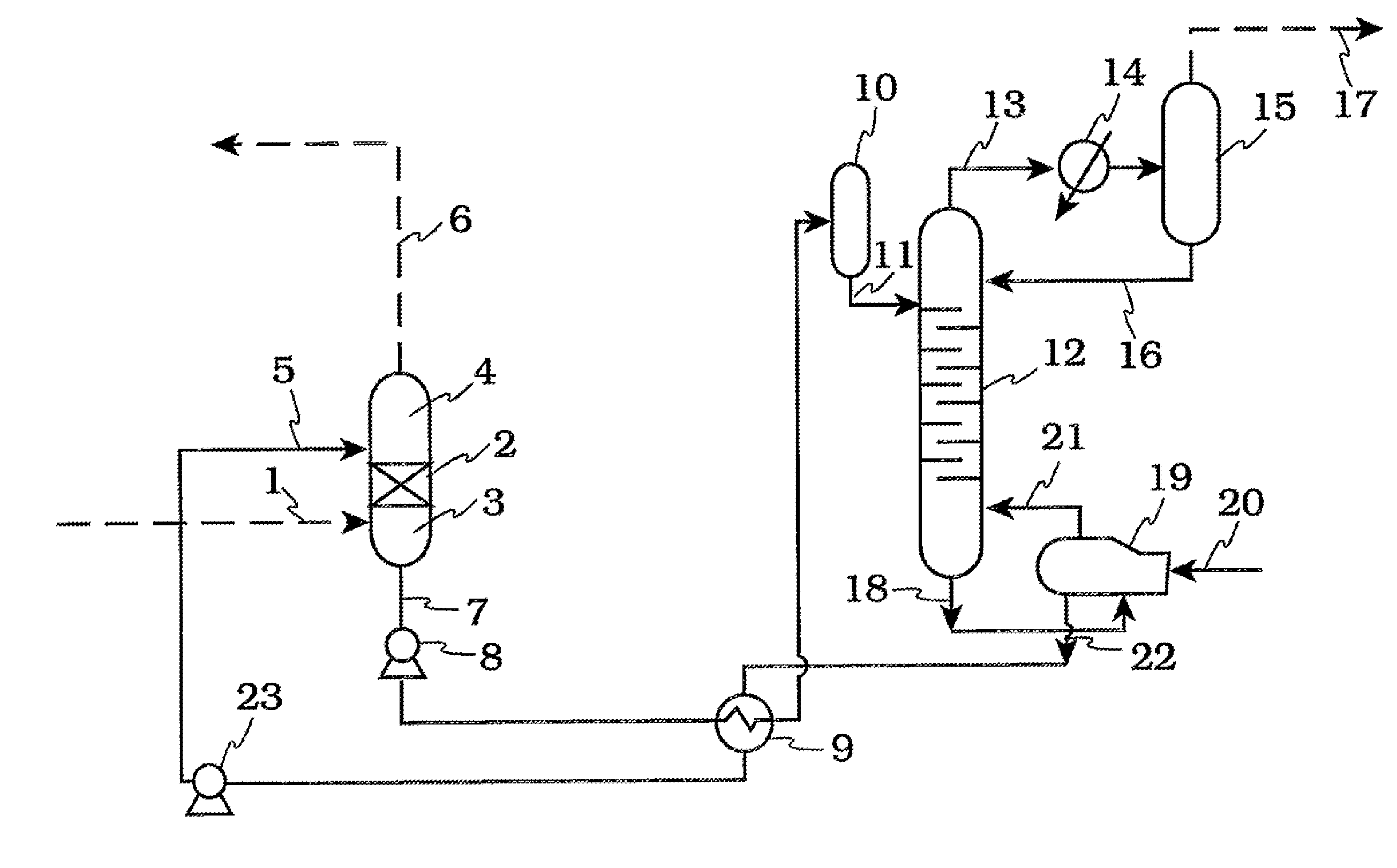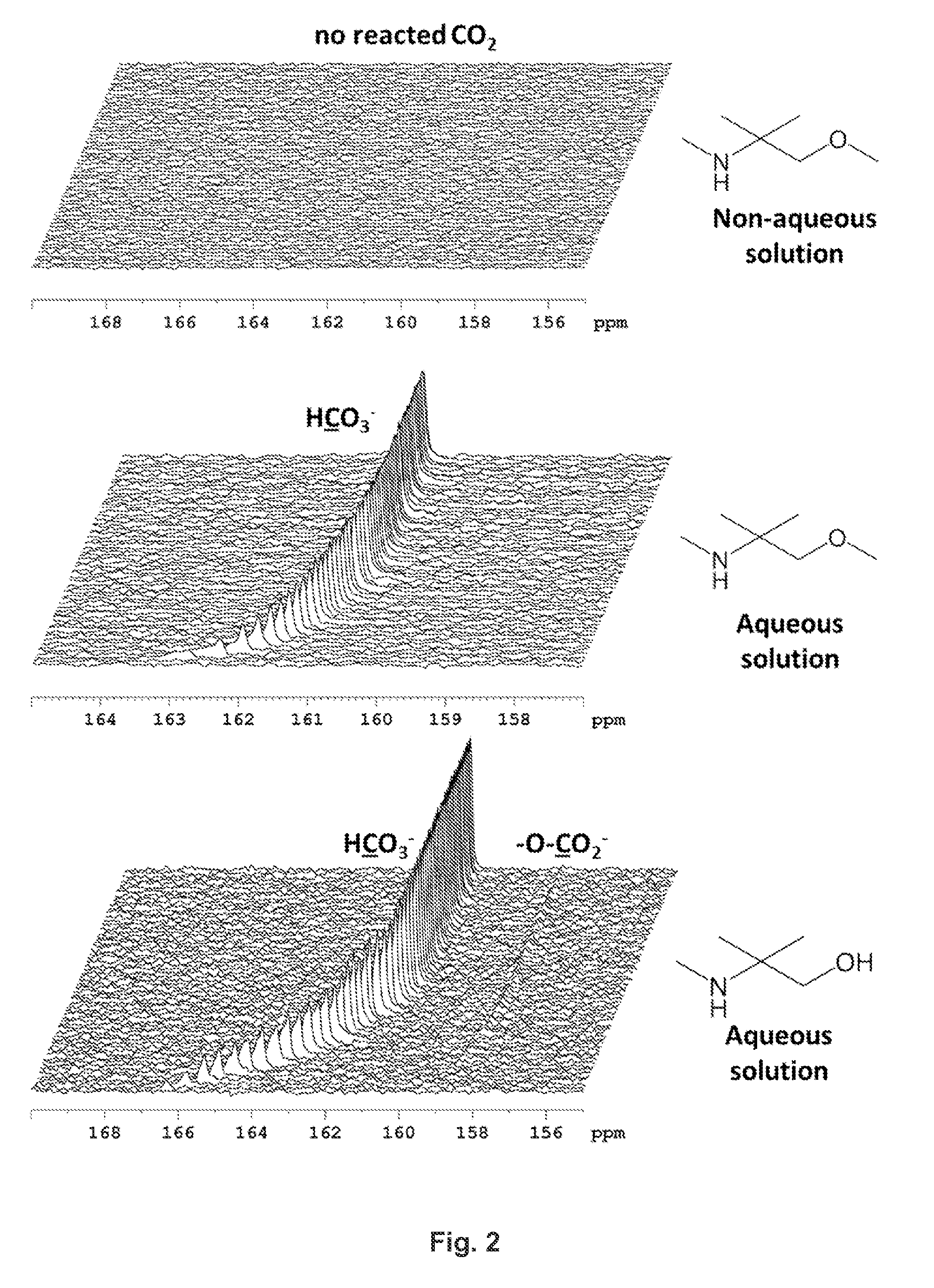Separation of hydrogen sulfide from natural gas
a technology of hydrogen sulfide and natural gas, which is applied in the direction of separation process, gaseous fuel, fuel, etc., can solve the problems of presenting its own problems, achieve low co2 solubility, improve the operation of sulfur recovery plant, and reduce the cost and energy
- Summary
- Abstract
- Description
- Claims
- Application Information
AI Technical Summary
Benefits of technology
Problems solved by technology
Method used
Image
Examples
example 1
Synthesis of 2-methoxyethyl-N-methyl-ethanolamine (MDEA-OMe)
[0098]
[0099]The secondary amine 2-N-methylaminoethanol (3.76 g, 0.05 mol), N,N-diisopropylethylamine (DIPEA) (6.46 g, 0.075 mol), 2-methoxyethyl bromide (7.30 g, 0.0525 mol) and 30 mL acetonitrile were placed in a round bottom flask and stirred at room temperature under nitrogen. After completion of the reaction, (˜6 h, monitored by HPLC) the reaction mixture was evaporated under reduced pressure in a rotary evaporator. The residue was dissolved in 50 mL of dichloromethane and washed with 50 mL of 50% sodium hydroxide solution in water. The aqueous layer was washed with 3×15 mL portions of dichloromethane. The collected organic fractions were dried over sodium sulfate and the solvent was then removed under reduced pressure in a rotary evaporator at low 0-5° C. to yield the crude product finally purified by fractional vacuum distillation under sodium hydroxide to yield the product (1.6 g, 0.013 mol, b.p. ˜115° C., pressure i...
example 2
Synthesis of bis-(2-methoxyethyl)-N-methylamine (MDEA-(OMe)2)
[0101]
[0102]Bis(2-methoxyethyl)amine (35.45 g, 0.26 mol) was cooled to 0° C. in a 2-L round-bottom flask containing a stir bar. Following dropwise addition of 88% aqueous formic acid (47 mL, 0.91 mol), 37% aqueous formaldehyde (56 mL, 0.69 mol) was added. Controlled heating to 60° C. initiated rapid gas evolution. The reaction was allowed to proceed without further heating until gas evolution decreased (˜6 h) and was then heated to 80° C. for 24 h. The reaction mixture was cooled, acidified with 20% aqueous HCl, and extracted three times with 100 mL portions of diethyl ether. The aqueous layer was stirred in a salt / ice bath and brought to pH 12 by dropwise addition of 40% aqueous NaOH without allowing the internal temperature to exceed 25° C. Following separation of the resulting amine / aqueous layers, the aqueous layer was further extracted three times with 100 mL portions of diethyl ether. The combined organic layers were...
example 3
General procedures for 2-methyl-3-methoxy-2-propylamine (AP-OMe) and 2,2-dimethyl-3-methoxy-2-propylamine (AMP-OMe) syntheses
[0104]This Example demonstrates the synthesis of two alkoxy propylamine derivatives in a three stage synthesis in which the amino group on an initial propanolamine compound is first protected by p-methoxyphenyl protection (PMP-protection) to form a protected aminoalcohol which is then methylated on the hydroxyl group after which the protecting PMP group is removed to form the final methoxy substituted amine.
Step 1 p-Methoxyphenyl Protection (PMP-Protection)
[0105]A mixture of the selected amino alcohol (1 eq) and p-anisaldehyde (1.1 eq) was heated under reflux in benzene with azeotropic removal of water during 24 hours. The reaction was concentrated under reduced pressure. The desired products were recrystallized from hexane.
[0106]PMP-AP-OH, was collected as white microcrystals in a yield of 96%. 1H NMR (300 MHz, CDCl3) δ 8.09 (s, 1H), 7.53 (d, J=8.7 Hz, 2H), 6...
PUM
| Property | Measurement | Unit |
|---|---|---|
| pressure | aaaaa | aaaaa |
| contact time | aaaaa | aaaaa |
| pressures | aaaaa | aaaaa |
Abstract
Description
Claims
Application Information
 Login to View More
Login to View More - R&D
- Intellectual Property
- Life Sciences
- Materials
- Tech Scout
- Unparalleled Data Quality
- Higher Quality Content
- 60% Fewer Hallucinations
Browse by: Latest US Patents, China's latest patents, Technical Efficacy Thesaurus, Application Domain, Technology Topic, Popular Technical Reports.
© 2025 PatSnap. All rights reserved.Legal|Privacy policy|Modern Slavery Act Transparency Statement|Sitemap|About US| Contact US: help@patsnap.com



